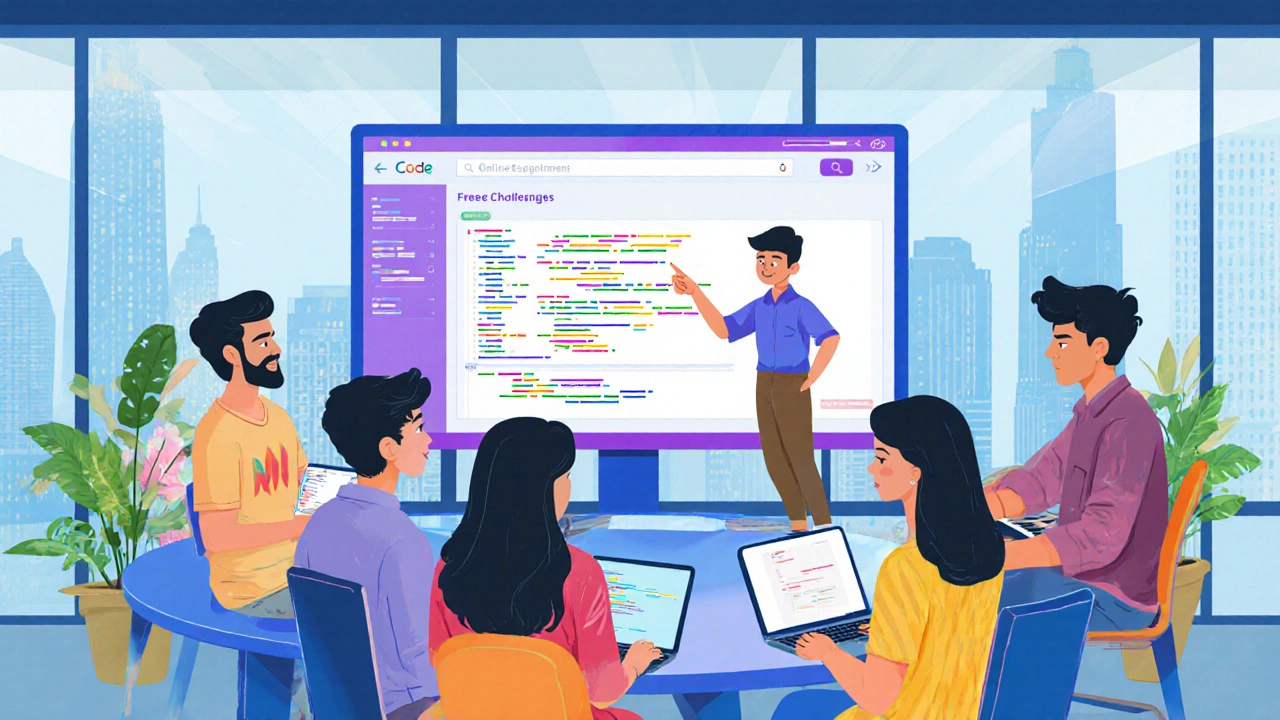
Coding Self-Learning Roadmap Planner
Plan your journey to becoming a self-taught developer. Enter your details below to get a personalized roadmap.
Many wonder if self-taught coding really works. The short answer: absolutely, but it takes the right mindset, a clear roadmap, and a toolbox of reliable resources. Below you’ll find a step‑by‑step plan that turns the idea of “learning on your own” into a concrete, achievable path.
TL;DR
- Set a realistic goal - a language, a project, or a job role.
- Pick one beginner‑friendly language (Python or JavaScript).
- Use free, structured platforms (FreeCodeCamp, Codecademy, Coursera).
- Practice daily, build small projects, and push code to GitHub.
- Join communities like Stack Overflow for feedback and motivation.
Is Teaching Yourself to Code Really Viable?
Learning to program without a classroom sounds like a myth, but the data tells a different story. According to a 2023 survey by Stack Overflow, over 55% of professional developers started as self‑learners. They cite flexibility, low cost, and the ability to follow their own pace as key advantages.
What makes it work? Three pillars:
- Clear outcomes - you need a destination, whether it’s building a website, automating tasks, or landing a junior dev job.
- Structured curriculum - aim for a sequence that gradually adds concepts rather than hopping between unrelated tutorials.
- Community feedback - code reviews and Q&A keep you from drifting into dead‑ends.
When these elements line up, self‑teaching matches or even outperforms formal education for many learners.
Blueprint: From Zero to First Program
Start with a simple, measurable milestone: write a program that prints “Hello, world!” on your screen. It sounds trivial, but it confirms that you have the development environment set up and that you understand the basic syntax of a language.
Here’s a concise 7‑step roadmap:
- Choose a language - for absolute beginners, Python a high‑level language praised for readable syntax and a massive library ecosystem or JavaScript the language of the web, enabling instant visual results in the browser are the safest bets.
- Set up the development environment - download the official interpreter (python.org) or use a browser‑based console for JavaScript. Install a lightweight editor like VS Code.
- Follow a beginner‑focused curriculum - we’ll compare three popular options below.
- Write code daily - even 30 minutes builds muscle memory.
- Complete mini‑projects - a calculator, to‑do list, or simple API client.
- Push code to GitHub - this creates a public portfolio and teaches version control.
- Get feedback - post questions on Stack Overflow or join Discord coding groups.
Stick to the sequence for at least 8 weeks, then reassess your progress.
Choosing a Language and Learning Platform
The biggest hurdle is picking where to start. Below is a quick comparison of three platforms that cater to self‑learners. They each offer a structured path, interactive exercises, and project‑based assessments.
| Platform | Cost | Primary Language Focus | Project‑Based Learning | Community Support |
|---|---|---|---|---|
| FreeCodeCamp | Free | JavaScript (full‑stack) | Yes - 5‑large certification projects | Active forum + Discord |
| Codecademy | Free tier + $39/mo Pro | Python, JavaScript, HTML/CSS | Yes - guided projects per course | Chat support, community forums |
| Coursera | $49/mo for Specializations | Varies - Python, Java, C++ | Capstone projects (often partner‑sponsored) | University‑backed discussion boards |
For absolute beginners, FreeCodeCamp’s zero‑cost model and clear JavaScript pathway make it an excellent launchpad. If you prefer a more guided experience with instant feedback, Codecademy’s Pro tier is worth the investment. Coursera shines when you want a credential from a university.

Building a Practice Routine That Sticks
Consistency beats intensity. Adopt the “Pomodoro‑style” approach: 25 minutes of focused coding followed by a 5‑minute break. Over a week, this adds up to roughly 6-7 hours of deliberate practice.
Key habits:
- Code on paper first - sketch algorithms before typing them.
- Use “learn by fixing” - take broken code snippets and debug them.
- Document your work - write a short README for each project on GitHub.
Tracking progress in a simple spreadsheet (date, topic, hours, outcome) helps you spot plateaus early.
Overcoming Common Roadblocks
Self‑learning isn’t a straight line. Here are the top obstacles and practical ways to bust through them.
- Feeling stuck on concepts - use “dual‑resource” learning. If a tutorial on loops feels vague, watch a Khan Academy video on the same topic, then apply it in a tiny script.
- Impostor syndrome - remember that even seasoned engineers reference documentation daily. Keep a “wins” journal of every bug you solve.
- Time constraints - turn commute time into micro‑learning. Listen to podcasts like "CodeNewbie" or read short articles on Medium while waiting.
- Isolation - join a local meetup (e.g., Wellington Coding Club) or an online Discord server dedicated to beginners.
When you hit a wall, schedule a 15‑minute “reset” session: step away, stretch, then return with fresh eyes.
Showcasing Your Skills to the World
Building a portfolio is the bridge between learning and employment. Aim for three polished projects:
- Web app - a personal blog built with JavaScript (React) or Python (Flask).
- Automation script - a Python tool that scrapes public data and outputs a CSV.
- Open‑source contribution - fix a typo or add a unit test to an existing GitHub repo.
Each project should have:
- A clear README outlining purpose, tech stack, and setup steps.
- Live demo (GitHub Pages, Netlify, or Heroku) if feasible.
- Link on your LinkedIn profile and resume.
Employers often look for evidence of problem‑solving, not just a degree. A well‑documented GitHub profile can substitute for a traditional transcript.
Next Steps & Troubleshooting
If you’ve followed the roadmap but still feel uncertain, try these quick diagnostics:
- Are you coding every day? If not, set a calendar reminder and treat it like a workout.
- Do you have real‑world output? Push at least one project to GitHub with a live demo.
- Are you getting feedback? Post a recent challenge on Stack Overflow and note the responses.
Adjust one variable at a time - more practice, a different language, or a new community - and monitor improvement over a 2‑week window.
Frequently Asked Questions
How long does it take to become job‑ready through self‑studying?
The timeline varies, but most self‑taught developers land junior roles after 6‑12 months of focused learning, 20‑30 hours per week, plus a solid portfolio of 3‑4 projects.
Do I need a computer science degree to understand core concepts?
No. Essential concepts like data structures, algorithms, and version control can be mastered via free resources and practice. A degree can help with theory depth but isn’t a gatekeeper for most entry‑level jobs.
Which language should I start with if I want to build websites?
JavaScript is the native language of the browser, so it’s the most practical starting point for front‑end work. Pair it with HTML/CSS, and you can create interactive sites from day one.
How can I stay motivated when progress feels slow?
Break goals into bite‑size milestones, celebrate each completed project, and regularly review how far you’ve come. Community challenges (e.g., 30‑day code sprints) also inject a fun competitive edge.
Is it worth paying for a coding bootcamp after self‑studying?
If you’ve built a foundation and need mentorship, structured interview prep, or a network, a reputable bootcamp can accelerate the jump to employment. However, many self‑taught developers succeed without spending thousands.
More Articles

Toughest Boards in India: CBSE vs ICSE Comparison, Facts & Insights
Discover which is the toughest board in India between CBSE and ICSE, with real stats, student perspectives, and essential tips to choose what's best for you.

Which State Performs Best in NEET? A Straightforward Look at Rankings and Reasons
This article breaks down which Indian states consistently top the NEET exam charts and digs into why some outperform others. It covers the numbers, talks about coaching trends, and checks what really drives high success in NEET. You'll find tips if you're looking to boost your NEET prep, plus some lesser-known facts about top states. Whether you want coaching advice or just the raw stats, this guide keeps it real and practical.

Is Physics Wallah Good for NEET? Honest Review for Serious Aspirants
Curious if Physics Wallah really delivers for NEET prep? This article gives you a straight answer, busting myths and sharing real insights from NEET aspirants. We cover the quality of teaching, resources, pricing, and things you won’t hear everywhere else. Get practical tips and honest opinions to help you choose your NEET coaching wisely. Whether you're a self-learner or need a routine, there's something useful here for everyone.
